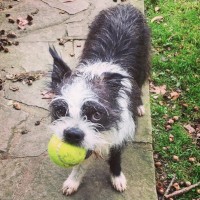Appearance of the Boston Malterrier
|
| The dark, expressive eyes of the Boston Maltese are large but do not protrude like those of the Boston Terrier. They often have a sparkle like the Maltese parent, giving an air of mischief to this dog's appearance. The muzzle can be short, with a small, dark nose. The Boston Malterrier can inherit the brachycephalic characteristics of the Boston Terrier, meaning the face may be slightly flattened. Its coat is black and white and the face may have the typical mask seen on the Boston Terrier parent. Ears are generally large and folded like the Maltese parent. Its medium-density coat can be stiff and is generally a little longer than the Boston Terrier coat. |
Temperament of the Boston Malterrier
|
| The Boston Malterrier's personality and character traits will be a blend of its two parents. It will be an intelligent, playful and gentle companion. The Boston Terrier is well-mannered and easy-going, but the Maltese can be a bit territorial and clingy. Early obedience training and socialization is recommended. The Boston Maltese can be prone to separation anxiety, which can lead to excessive barking and chewing. Positive reinforcement when training is essential, as is praise on leaving the house and on returning. Your Boston Malterrier can benefit from a kennel; often, a dog will feel less anxiety when it has its own space to retreat to when the house is empty. |
Needs and activities of the Boston Malterrier
|
| This lively little hybrid loves to walk. Wherever you go, he'll be happy to follow. Short bursts of activity are fine; a trip to the dog park to socialize with friends, a meet-and-greet session on the street with the neighbors, or a romp in the fenced-in backyard are all appropriate outings. This dog is not supposed to be left alone in the yard unsupervised, however, he won't be happy about it and will bark, and perhaps try to dig his way out. Best in a house in an urban or rural area, he's also fine in an apartment, as long as he's not left alone for long periods. He barks and causes a fuss. |
Maintenance of the Boston Malterrier
|
| If your Boston Malterrier has a medium to long coat, it will need daily brushing and combing. A pin brush works very well in this type of coat, care should be taken to ensure that tangles are removed daily. Often, they can be worked out with the fingers. If the fur tends to grow between the toes, trim it weekly. His coat may need bathing twice a month with a mild shampoo. Small dogs can often have teething problems, so your Boston Malterrier's teeth need daily care. |









 English (United Kingdom)
English (United Kingdom)